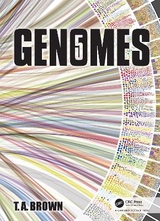
Genomes 4
Crc Press Inc (Verlag)
978-0-8153-4508-4 (ISBN)
- Titel erscheint in neuer Auflage
- Artikel merken
Genome sequencing and assembly methods have been thoroughly revised including a survey of four genome projects: human, Neanderthal, giant panda, and barley. Coverage of genome annotation emphasizes genome-wide RNA mapping, with CRISPR-Cas 9 and GWAS methods of determining gene function covered. The knowledge gained from these techniques forms the basis of the three chapters that describe the three main types of genomes: eukaryotic, prokaryotic (including eukaryotic organelles), and viral (including mobile genetic elements). Coverage of genome expression and replication is truly genomic, concentrating on the genome-wide implications of DNA packaging, epigenome modifications, DNA-binding proteins, non-coding RNAs, regulatory genome sequences, and protein-protein interactions. Also included are applications of transcriptome analysis, metabolomics, and systems biology. The final chapter is on genome evolution, focusing on the evolution of the epigenome, using genomics to study human evolution, and using population genomics to advance plant breeding. Established methods of molecular biology are included if they are still relevant today and there is always an explanation as to why the method is still important.
Each chapter has a set of short-answer questions, in-depth problems, and annotated further reading. There is also an extensive glossary. Genomes 4 is the ideal text for upper level courses focused on genomes and genomics.
Terry Brown is professor of Biomolecular Archaeology at Manchester University. As well as writing the previous editions of Genomes, he is the author of Introduction to Genetics: A Molecular Approach (Garland 2011) and 5 editions of DNA Cloning & Analysis (Wiley Blackwell). He is also an experienced teacher of genetics.
PART 1 HOW GENOMES ARE STUDIED
1. Genomes, Transcriptomes and Proteomes
2. Studying DNA
3. Mapping Genomes
4. Sequencing Genomes
5. Genome Annotation
6. Identifying Gene Functions
PART 2 GENOME ANATOMIES
7. Eukaryotic Nuclear Genomes
8. Genomes of Prokaryotes and Eukaryotic Organelles
9. Virus Genomes and Mobile Genetic Elements
PART 3 HOW GENOMES ARE EXPRESSED
10. Accessing the Genome
11. The Role of DNA-Protein Interactions in Genome Expression
12. Transcriptomes
13. The Proteome
PART 4 HOW GENOMES REPLICATE AND EVOLVE
14. Replicating the Genome
15. Microevolution of Genomes
16. A Brief History of Genome Evolution
17. Using Genomes to Study the Evolution of Species and Populations
| Erscheinungsdatum | 30.06.2017 |
|---|---|
| Zusatzinfo | 50 Halftones, color; 500 Illustrations, color |
| Verlagsort | Bosa Roca |
| Sprache | englisch |
| Maße | 219 x 276 mm |
| Gewicht | 1088 g |
| Themenwelt | Informatik ► Weitere Themen ► Bioinformatik |
| Naturwissenschaften ► Biologie ► Genetik / Molekularbiologie | |
| ISBN-10 | 0-8153-4508-9 / 0815345089 |
| ISBN-13 | 978-0-8153-4508-4 / 9780815345084 |
| Zustand | Neuware |
| Informationen gemäß Produktsicherheitsverordnung (GPSR) | |
| Haben Sie eine Frage zum Produkt? |
aus dem Bereich



